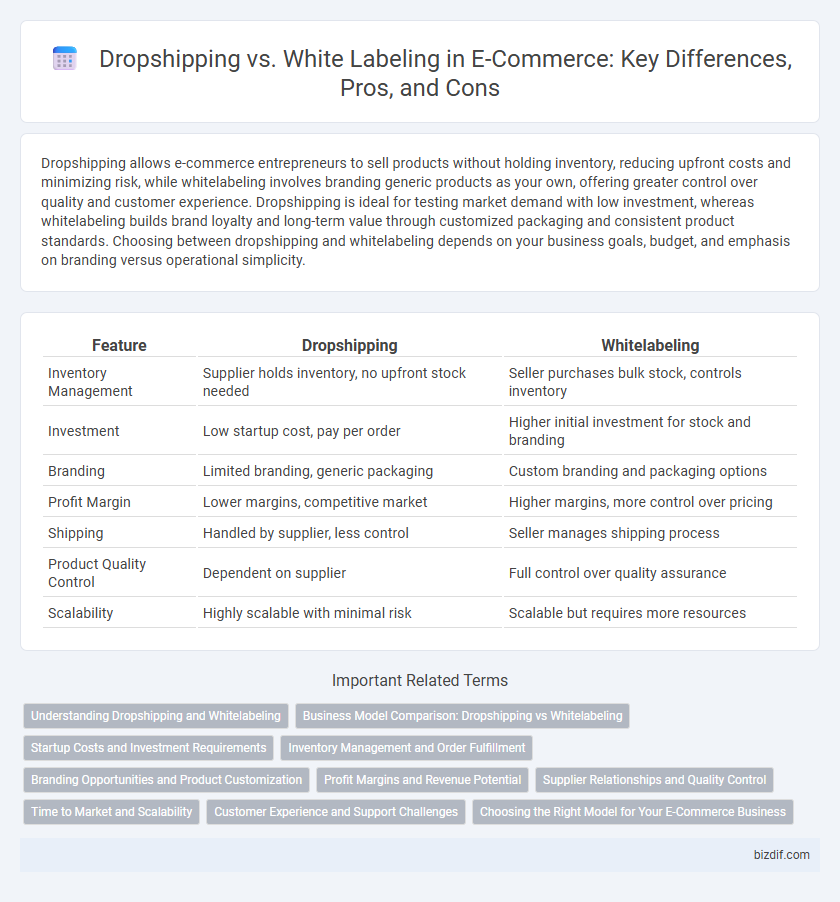Dropshipping allows e-commerce entrepreneurs to sell products without holding inventory, reducing upfront costs and minimizing risk, while whitelabeling involves branding generic products as your own, offering greater control over quality and customer experience. Dropshipping is ideal for testing market demand with low investment, whereas whitelabeling builds brand loyalty and long-term value through customized packaging and consistent product standards. Choosing between dropshipping and whitelabeling depends on your business goals, budget, and emphasis on branding versus operational simplicity.
Table of Comparison
| Feature | Dropshipping | Whitelabeling |
|---|---|---|
| Inventory Management | Supplier holds inventory, no upfront stock needed | Seller purchases bulk stock, controls inventory |
| Investment | Low startup cost, pay per order | Higher initial investment for stock and branding |
| Branding | Limited branding, generic packaging | Custom branding and packaging options |
| Profit Margin | Lower margins, competitive market | Higher margins, more control over pricing |
| Shipping | Handled by supplier, less control | Seller manages shipping process |
| Product Quality Control | Dependent on supplier | Full control over quality assurance |
| Scalability | Highly scalable with minimal risk | Scalable but requires more resources |
Understanding Dropshipping and Whitelabeling
Dropshipping allows e-commerce businesses to sell products without holding inventory, as suppliers ship items directly to customers, minimizing upfront costs and reducing risk. Whitelabeling involves branding generic products with a retailer's own label, offering control over product quality and branding while requiring inventory management and upfront investment. Understanding these models helps entrepreneurs choose a strategy that aligns with their operational capacity, brand goals, and financial resources.
Business Model Comparison: Dropshipping vs Whitelabeling
Dropshipping eliminates the need for inventory by directly shipping products from suppliers to customers, reducing upfront costs and risks, whereas whitelabeling involves purchasing products in bulk to rebrand and sell under your own label, allowing higher control over branding and profit margins. Dropshipping offers ease of entry with minimal investment, but lower profit margins and less control over product quality and shipping times. In contrast, whitelabeling demands a larger initial investment and inventory management but provides enhanced brand recognition, custom packaging options, and potential for long-term scalability.
Startup Costs and Investment Requirements
Dropshipping requires significantly lower startup costs as it eliminates the need for inventory purchase and warehousing, making it ideal for entrepreneurs with limited capital. Whitelabeling demands higher initial investment due to product manufacturing, branding, and inventory management expenses. Understanding these financial differences helps e-commerce startups allocate resources efficiently and select a business model aligned with their budget and growth goals.
Inventory Management and Order Fulfillment
Dropshipping eliminates the need for inventory management by directly shipping products from suppliers to customers, reducing overhead costs and minimizing storage risks. Whitelabeling requires maintaining inventory to ensure timely order fulfillment, allowing for greater control over product branding and customer experience. Effective supply chain coordination is crucial in both models to optimize delivery speed and maintain customer satisfaction.
Branding Opportunities and Product Customization
Dropshipping offers limited branding opportunities as products are sourced directly from suppliers, restricting customization and unique packaging options. Whitelabeling allows full control over product design and branding, enabling businesses to create distinct brand identities and tailored customer experiences. Enhanced product customization in whitelabeling drives stronger brand loyalty and differentiation in competitive e-commerce markets.
Profit Margins and Revenue Potential
Dropshipping offers lower profit margins typically ranging from 10% to 30% due to third-party fulfillment costs, while whitelabeling can boost margins up to 50% by controlling production and branding. Revenue potential increases with whitelabeling because customized products allow premium pricing and customer loyalty, unlike dropshipping where competition limits pricing power. E-commerce entrepreneurs prioritizing higher profitability and brand scalability often prefer whitelabeling despite increased upfront investment and inventory risks.
Supplier Relationships and Quality Control
Dropshipping relies heavily on supplier relationships, making consistent communication and trust essential for timely order fulfillment and product quality. Whitelabeling allows greater control over product standards since businesses typically work closely with manufacturers to customize and oversee production processes. Strong supplier partnerships in whitelabeling facilitate strict quality control, reducing the risk of defects compared to the often variable quality in dropshipping arrangements.
Time to Market and Scalability
Dropshipping offers rapid time to market by eliminating inventory management, allowing sellers to launch products quickly with minimal upfront investment. Whitelabeling involves more preparation and brand customization but provides greater scalability through improved control over product quality and profit margins. E-commerce businesses seeking swift entry prioritize dropshipping, while those aiming for long-term growth and brand development often choose whitelabeling.
Customer Experience and Support Challenges
Dropshipping often faces customer experience challenges due to limited control over product quality and shipping times, which can lead to inconsistent service and delayed issue resolution. Whitelabeling offers enhanced support capabilities by enabling businesses to customize products and manage inventory, resulting in faster response times and improved customer satisfaction. Effective communication and streamlined returns processes remain critical to maintaining trust and loyalty in both models.
Choosing the Right Model for Your E-Commerce Business
Choosing between dropshipping and whitelabeling significantly impacts your e-commerce business's profitability and brand control. Dropshipping offers low upfront investment and inventory-free operations, while whitelabeling provides greater customization and brand identity with higher initial costs. Analyzing factors like target market, budget, and long-term goals helps identify whether the low-risk flexibility of dropshipping or the scalable branding potential of whitelabeling suits your e-commerce strategy best.
Dropshipping vs Whitelabeling Infographic

 bizdif.com
bizdif.com